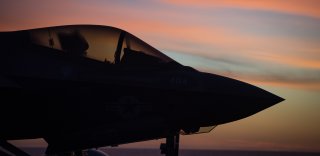Drone-Refueled F-35C Jet Could Counter Chinese Anti-Ship Missiles
For the first time, the emerging Navy MQ-25C Stingray carrier-launched tanker drone refueled an F-35 jet, effectively doubling its range of attack from the sea.
The aerial refueling of an F-35 jet might not seem particularly consequential, as fighter jets have been refueled from the air for decades. But what if it were a carrier-launched Navy F-35C fighter jet that could be refueled over the ocean by a carrier-launched refueler drone? That does change things.
For the first time, the emerging Navy MQ-25C Stingray carrier-launched tanker drone refueled an F-35 jet, effectively doubling its range of attack from the sea. Of course, this opens up an entirely new sphere of mission possibilities to include additional surveillance, targeting, networking and offensive strike capabilities. Also, at the same time, it accomplishes the specific and extremely critical task of being able to attack from beyond the striking range of a particularly deadly Chinese “carrier-killer” missile reported to be able to strike ships as far as one thousand miles offshore. Of course, aircraft carriers have increasingly layered defense systems with new weapons that could potentially include laser interceptors, electronic warfare missile guidance jamming systems and various ship-fired or ship-mounted interceptors. Navy leaders say that aircraft carriers will be able to operate from anywhere despite threats posed by Chinese-guided anti-ship missiles. Nonetheless, the range extension for ocean-launched F-35C jets is extremely significant because it gives commanders a much greater range of tactical attack options as well an increased ability to survive attacks.
According to Lockheed Martin, the F-35C fighter jet operates with a combat radius of roughly five hundred to six hundred nautical miles, which means once it travels that distance, it must turn around and return if not refueled.
The math shows that a Chinese DF-21D anti-ship guided missile can travel as far as nine hundred to one thousand nautical miles. That means an F-35C jet might not be in striking range of an enemy land target if the carrier had to operate more than one thousand miles offshore. An F-35 jet could not get to its target if it was to take off one thousand miles away because it would need to turn around before arriving over a target area. An F-35 jet refueled from the air, however, could reach the skies above land targets and operate with dwell time sufficient to search for targets and respond to new intelligence should new targets emerge.
Now, in the case of the Chinese DF-26, the circumstances could be a little different given that that weapon can reportedly hit ranges as far as two thousand miles offshore (Note: Estimates vary). However, given that the F-35 fighter jet can function as a proven aerial intelligence, surveillance, and reconnaissance node able to locate targets and share data from beyond the horizon at extremely significant distances, having double the range of an F-35C jet introduces an entirely new sphere of networking possibilities. An F-35C jet could operate as a surveillance node within a broader multi-domain network such that it could cue other aircraft, alert surface ships of approaching targets and even help guide long-range missiles to their targets.
Kris Osborn is the defense editor for the National Interest. Osborn previously served at the Pentagon as a Highly Qualified Expert with the Office of the Assistant Secretary of the Army—Acquisition, Logistics & Technology. Osborn has also worked as an anchor and on-air military specialist at national TV networks. He has appeared as a guest military expert on Fox News, MSNBC, The Military Channel, and The History Channel. He also has a Master's Degree in Comparative Literature from Columbia University.
Image: Flickr / Officials U.S. Navy Page

